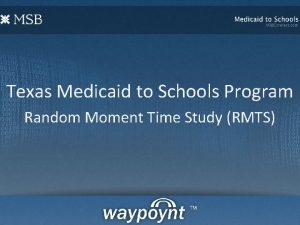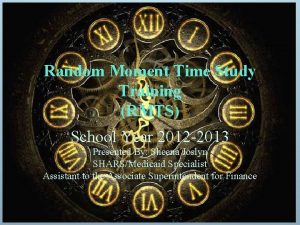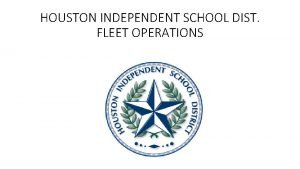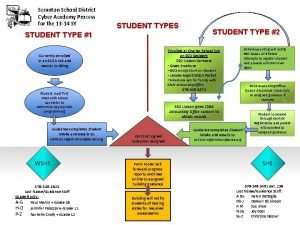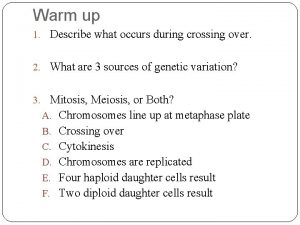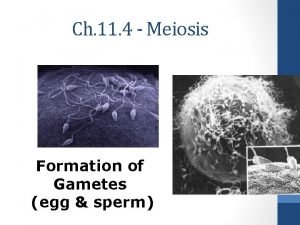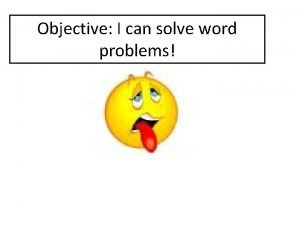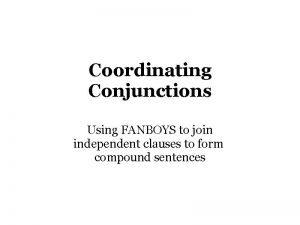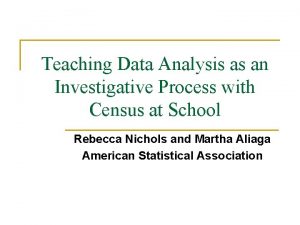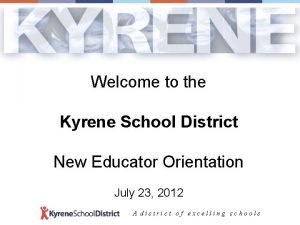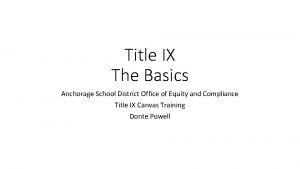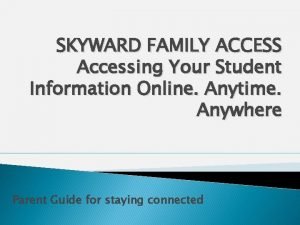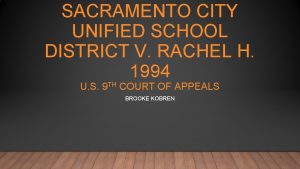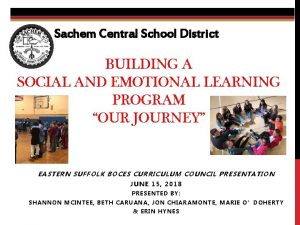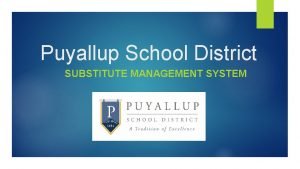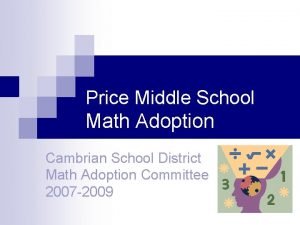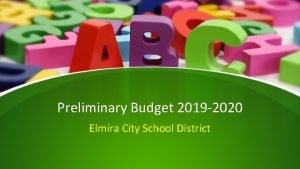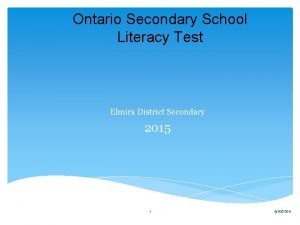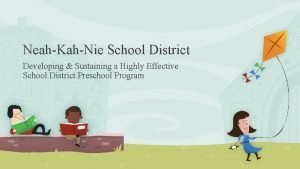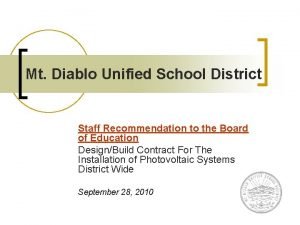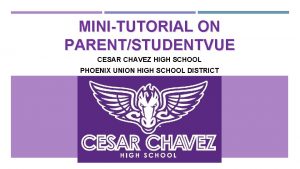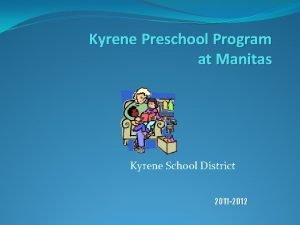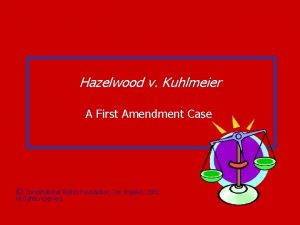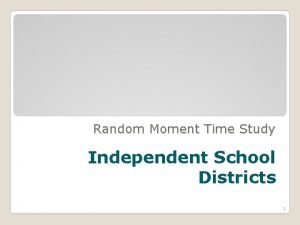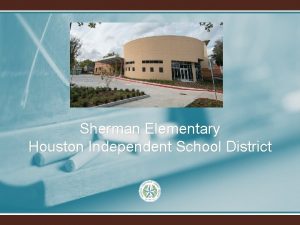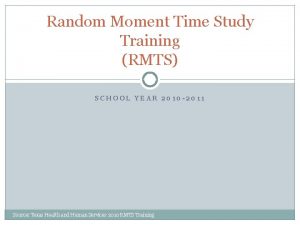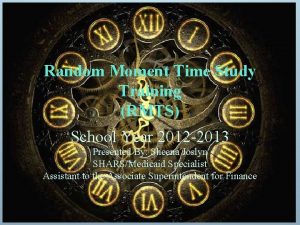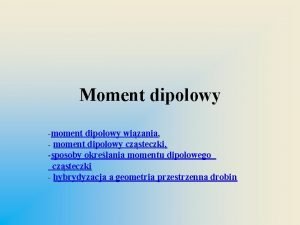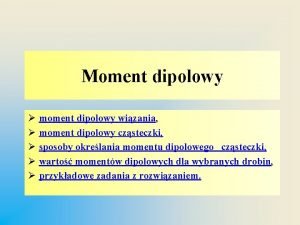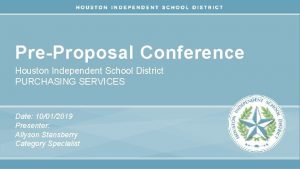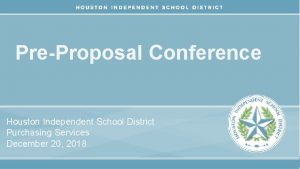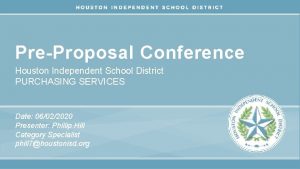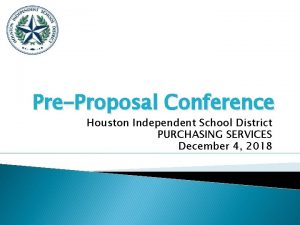Random Moment Time Study Houston Independent School District







































- Slides: 39

Random Moment Time Study Houston Independent School District Medicaid Finance and Consulting Services 2018 – 2019 School Year 1

Overview – What is Random Moment Time Study (RMTS)? • A federally accepted statistically valid random sampling technique that measures the participant’s time performing work activities • A RMTS “Moment” represents one minute of time that is randomly selected from all available moments within the time study period • Statewide time study sample • Regardless of what district the time study participant is at once the moment has occurred please logon to STAIRS and respond to the series of questions documenting the activity being performed and the name of the district • Significantly reduces staff time needed to record participant activities 4

Overview – Purpose of RMTS • Determine the percentage of time the ISD incurs assisting individuals to access medically necessary Medicaid funded services • Direct Medical Services • Medicaid Outreach • Medicaid Eligibility Determination • Medicaid Referral, Coordination, and Monitoring • Medicaid Staff Training • Medicaid Transportation • Medicaid Translation • Medicaid Program Planning, Development & Interagency Coordination • Medicaid Provider Relations • Reasonably identifies staff time spent on activities during the given quarter. 5

Overview – Time Study Activities Direct Medical – Providing care, treatment and/or counseling Outreach – Informing students, families and groups about available services Eligibility – Assisting students or families with the Medicaid eligibility process Referral, Coordination, and Monitoring – Making referrals, coordinating and/or monitoring activities on a student’s IEP Staff Training – Coordinating, conducting or participating in training pertaining to medical or Medicaid services Translation – Arranging or providing translation to a student or family to access medical or Medicaid services Transportation – (Exclude bus drivers) aides and monitors accompanying students in need of personal care services or arranging transportation to medical services Program Planning, Development & Interagency Coordination – Developing strategies to improve the coordination and delivery of medical or Medicaid services Provider Relations – Activities to secure and maintain Medicaid providers 6

Requirements – Important Dates Event Opens/Begins Closes/Ends Participant List (PL) 05/16/2018 09/14/2018 09/15/2018 12/14/2018 03/08/2019 1 st Quarter TS 10/01/2018 12/11/2018 2 nd Quarter TS 3 rd Quarter TS 01/09/2019 04/01/2019 03/29/2019 05/31/2019 (6 p. m. CT) 1 st Quarter PL 2 nd Quarter PL 3 rd Quarter PL Time Study (TS) * Dates are subject to change 9

Training Update Personal Care Services are not being documented appropriately when responding to the time study. As a result there will be follow-up questions when this occurs. As the RMTS Contact you are responsible for training the time study participants on the following as it pertains to personal care services. • A personal care service is a direct medical service • A student receiving a personal care service should have an IEP that list the specific activity and/or personal care service needed • Personal Care Service providers should know when responding to a time study moment the response should be restricted to the one minute in time. Do not list multiple activities or their job description/responsibilities • A response should always include the specific PC activity (cueing, monitoring) and the service being provided • When responding to a time study moment if the “Why” states “to provide a direct medical service as defined on a student IEP” then the “What” should clearly define what the direct medical service was. • In situations where lesson planning is being done please indicate the specific student audience and if it is IEP related. 11

Personal Care Services • Personal care services (PCS) are provided to assist a student with a disability or chronic health condition so they may benefit from school/educational services • Personal care services include a range of human assistance provided to students to accomplish tasks the student would normally do for themselves if they did not have a disability A student may be physically capable of eating lunch but is unable to independently eat in the cafeteria because of functional, cognitive, or behavioral impairments • PCS may be provided by a wide range of school personnel Teacher Aides Bus Aides/Monitors Health Care Aides Orientation/Mobility Instructional Aides Specialists Teachers Bilingual Aides Clerks 35

Personal Care Services • Include but are not limited to: • Eating/feeding Monitoring Meal preparation Redirection Personal hygiene Cueing Toileting Positioning • Maintaining continence Dressing Ambulation Intervening with behaviors Respiratory assistance • Grooming Assisting with self administering medication • Transferring 36

Personal Care Services are often provided in Life Skills/ Self-Contained classrooms because: • The Life Skills class consists of students with Moderate to Severe disabilities, showing limitations in communication, social skills, and activities of daily living (ADL) • The course curriculum is driven by the student’s needs as stated in each student’s IEP • These classes may have different skill areas addressed based on student needs, like Domestic skills Daily living skills Pre -vocational skills Vocational skills Social skills 37

Educational or Direct Medical? Direct Medical Services Include: Medical services that require a licensed, skilled, trained professional • Nursing • Psychology • Counseling • OT, PT, Speech, • Evaluations Personal Care Services Activities that require human intervention to accomplish the task the student would normally do for themselves if they did not have a disability or chronic medical condition, i. e. , hands on assistance, monitoring, cueing, redirection, Activities of Daily Living (ADL) 38

Educational or Direct Medical? Educational Services Include: • Reading/English/Language Arts • Writing • Mathematics • Science • Social studies • Physical education • Electives • Activities that do not require human intervention to accomplish the task the student would normally do for themselves if they did not have a disability or chronic medical condition 39

Educational vs. Direct Medical/PCS A teacher helping a student solve a math problem that they are having difficulty understanding. A PCSP is assisting a student solve a math problem by providing hand over hand assistance using a calculator. A teacher demonstrating sounding out words during a reading lesson. A Speech Therapist is working with a student on an articulation exercise A teacher in an inclusion class is teaching a Social Studies lesson. A teacher’s aide is monitoring and cueing students in an inclusion class during a Social Studies lesson to stay seated. 40

Educational vs. Direct Medical/PCS A Licensed Specialist in School Psychology providing academic counseling to a student. A Licensed Specialist in School Psychology providing relaxation therapy to a student as part of their defined BIP. A Nurse teaching students in a health class the benefits of proper hand washing. A Delegated Nurse assisting a diabetic student in washing their hands prior to checking their blood sugar per the IEP. A PCSP in the cafeteria monitoring all students. A PCSP in the cafeteria cueing a student to swallow between bites during lunch. 41

What Is Monitoring ? Monitoring is a Direct Medical Service when: • The student just received medication as indicated on his/her IEP. The participant is monitoring the student for a reaction. This activity is a delegated nursing service • Student’s IEP requires that he/she receive continuous monitoring due to a behavior problem. This activity is a personal care service (PCS) • The teacher’s aide is monitoring a student in a wheelchair to ensure they do not slide down in their wheelchair. This activity is a personal care service (PCS) Monitoring is an Educational Service when: • General monitoring of students in a cafeteria to ensure all students’ behaviors are in accordance with school policy. This activity is general supervision of students 42

Moment - General • Time study “moments” are randomly selected throughout the entire quarter. • A time study “moment” represents one minute at the selected time. • If a participant is sampled for a “moment, ” their only responsibility is to document what they were doing at that precise minute. • Some options have hover-overs or question marks that provide additional information that helps the participant make the best selection. 43

RMTS Moment • Sampling and Notification • Participant Questions New • Drop down responses • System Demonstration • Moment Completion 44

RMTS Moment – Notification Example of E-mail sent to selected participants 45

Moment - Welcome Screen www. fairbanksllc. com 46

Moment - Login Screen 47

Moment - Start RMTS 48

Moment - Instruction Screen 49

Participants 3 Question Model FAIRBANKS R a n d o m M o m e n t Time Study Welcome , Y o u r P r o f i le (. L. 2 Q. QJ. It) (E d i t) Nam e : Email: 0 YOUR TIME STUDY IS NOT COMPLETE. <l) R a n d o m M o m e n t Tim e : 0 9 / 2 6 1 2 0 1 7 , 0 8 : 1 0 A M C e n tr a l T i m e Program : M A C C a te g o r y : B e h a v i o r a l C o u n s e l o r ( M A C O N LY ) R e f e r e n c e M a t e ri a l s 1. W h o w a s wit h y o u ? P l e a s e lect a n s w e r. . . Rr. 1 TS Information W e b s r t e < I X - H H S C > (M Rr. t. TS Portlcloant M a n u a 1 2 - 1 1 - 0 9 D o Yo u N e e d H e lp ? 2 W h a t w e r e vou doina? 3 W h a t w e re yo u d o in g ? P l e a s e d e s c n b e o n l y th e O N E s e r v c e t h a t y o u w e r e M O S T 1 nvolved 1 n ( c u e i n g , r e d i r e c t i o n prompt 1 ng s t a f f m e e t m g t e a c h i n g. r e a d i n g m o n 1 t o n n g t h e r a p y evaluat 1 on t e s t m g l u n c h , e t c ) : 3. w ny w e re you p e n o rm mg tn 1 s a c-ti. VJty "f P le a s e a ns w e r the above questions to s e e the a v a ila b le a n s w e r s for this question. I c o n f i r m t h a t m y r e s p o n s e a b o v e is a n a c c u r a t e re p r e s e n tat io n a n d d e s c r iptio n o f m y a c t M (y/ activiti e s d u r i n g th e R a n d o m M o m e n t T i m e Stu ely ( R M TS ) s a m p le d at e a n d t im e. I c e r tify th a t 1 a m t h e I n d i v i d u a l a u th oriz. ed t o c o m p l e t h is R M T S a s I n d i c a t e d 1 n t h e u p p e r rig ht h a n d c o r n e r o f t h is s c re e n I a l s o co nfir m t h a t I h a v e r e c e i v e d t r a in i n g re g a r d i n g m y p a r t i c i p a t i o n a n d t h e a c c u r at e c o m p l e t i o n of t h is R M T S f o r m. @ ertify & S u b @ £ ] F o r q u e s tio n s , p l e a s e c o n t a c t F a i r b a n k s L L C C l i e n t Info r m a t io n C e n t e r ( 8 8 8 ) 3 2 1 - 1 2 2 5 o r. n f o @ f a o r b a n ksl!c c o m F o r a ny additiona l q u e s t i o ns , p a s e contact the Feurbank. s Cfient lnfonnatton C e n t e r at (888) 3 2 1 -1 2 2 5.

Moment - Questions • WHO Was With You ? • WHAT Were You Doing ? • WHY Were You Doing It ? 52

Personal Care Service Providers (PCSP) get 1 additional question WERE You Providing Personal Care Services? WHO Was With You ? WHAT Were You Doing ? WHY Were You Doing It ? 53

PCSP 4 Question Model FAIRBANKS Welcome Random Moment Time Study Profile ) N amr a n eil. : : E 0 <l) Your ( YOUR n M E STUDY IS t 40 T C O M P L E TE. P r o g ra m : M A C C at e g o r y : Provtder R a ndom Personal Care Servtce M o m e n t Tim e : 0 7 / 0 3 1 2 0 1 7. 0 8 : 0 1 A M C e n t r a l T i m e Reference r. Q 1 W e r e y o u p r o v i d i n g P e r s o n a l C a r e S e r v ic e s ? P le a s e c_lt t o r e v ie w e x a m p le s o f P e r s o n a l c a. -e (i!J M a t e r ia l s R M Tn. Slf o n n a h o n W e b s r t e OX - H H SC l R M T S p o d !C !QOOt M a o y a 1 2 - 1 1 - 0 9 S e r v i c e s b e f o re c o n t i n u i n g. Do You P l e a s e le c t a n s w e r. . . Need Help? F o r n n y a d d i t i o n a l que: a. Uon. s , p 2 a s - e con tact the F a. - b a n k s C U en t ln f o n n a t i o n C e n t e r a t W h o w a s w it h y o u ? ( I 3 2 1 - 12 2 5. P l e a s e lec t a n s w e r. . . 3 W h a t w e re y o u d o ing ? P le a s e d e s c n b e o n l y t h e O N E sennce that you were MOST mvotved m (cuemg red • rect 1 on prompt 1 ng staff meetmg 4. W h y w e re yo u a c t iv i t y ? P le a s e t e a c h m g. r e a d m g. m o n 1 to n n g therapy evalu at 1 on testmg lunch. etc ) performing this s e le c t an a n s w e r. . . I c o n f i r m t h a t m y r e s p o n s e a b o v e i s a n a c c u r a te r e p r e s e n t a t i o n a n d d e s c n p tl o n o f m y a c t l v t t y / a c tlv tt l e s d u r i n g t h e R a n d o m M o m e n t T im e S t u d y (R M T S ) s a m p l e d a t e a n d tim e 1 c e rtify th a t 1 a m th e i n d i v i d u a l a u t h o r i z e d to c o m p l e te t h i s R M T S a s I n d i c a t e d 1 n t h e u p p e r r ig h t h a n d c o m e r o f t h i s s c r e e n. I a l s o c o n f i r m t h a t 1 h a v e r e c e i v e d t r a i n • n g r e g a r d i n g m y p a r tl d p a tt o n a n d t h e a c c u r a t e c o m p l e t i o n o f t h i s R M T S f o r m @ artily & S u b m i ! J F o r q u e s t i o n s. p l e a s e c o n t a c t F a i r b a n k s L L C C l i e n t I n f o r m a t i o n C e n t e r. { 8 8 8 ) 3 2 1 - 1 2 2 5 o r l n f o @ f a tr p a n k s l l c c o r n 54

Response – PCSP only Question: Were you providing Personal Care Services? 55

Response – Drop Downs Question: Were you providing a personal care services (PCS)? 1. Yes and the service was defined on the student’s or students’ IEP(s) Yes and the service was NOT defined on the student’s or students’ IEP(s) 2. No 56

Response Question: Who was with you? 57

Response – Drop Downs Question: Who Was With You? 1. 2. 3. 4. 5. 6. 7. 8. Special Ed student with health Impairment (chronic medical condition) Special Ed student with physical disability Special Ed student with intellectual disability (IDD) Special Ed student with mental health/psychological disability (emotionally disturbed, etc. ) Special Ed student with autism Student not Special Ed Student with learning disability (dyslexia, reading difficulty, language difficulty) Multiple students All with either a disability or medical impairment Some with disability or medical impairment and some with no disability or impairment All without any disability or medical impairment 58

Response – Drop Downs Question: Who Was With You? 9. 10. 11. 12. Teachers, Aides, or School Administrator(s) Contract Provider(s) No one, alone Not Working Paid time off Unpaid time off 13. Other 59

Response – Question: What were you doing? 60

Response – Question: What were you doing? (Text Box) Typically 2 -4 sentences that provides specific information about what you were doing at that minute Please keep in mind : • When providing PCS the “WHAT” is more about why the student needs your support rather than what is going on in the class. • You are describing exactly what took place only in the 60 seconds of the moment • The person coding the moment has no background or knowledge of ISD job descriptions; tasks performed or what Special Education is. • Don’t use acronyms in the description • Don’t use people’s names in the responses • If not working, indicate if it was paid or unpaid time off 61

Response – Question: Why were you performing this activity? 62

Response – Drop Downs Question: Why were you performing this activity? 1. 2. 3. 4. 5. 6. To ensure safety for student(s) from self, others, environment that they cannot perceive independently To keep the student on task, in seat, awake that they cannot manage independently To assist the student physically To assist the student intellectually (read or repeat instructions, demonstration, hand over hand) To assist the student toileting Pre K Kindergarten Elementary school Middle school High school To monitor the student that requires supervision or physical assistance 63

Response – Drop Downs Question: Why were you performing this activity? 7. To transition the student that requires supervision or physical assistance 8. To assist the student feeding/eating that requires supervision or physical assistance 9. To monitor/intervene with behaviors (aggression, self stimulation, verbal interference, etc. ) With BIP (Behavioral Intervention Plan) Without BIP 10. To provide Dr. prescribed medication/medical care Per IEP Without IEP 11. To provide other medical care/first aide 12. To provide therapy (Speech, OT, PT, Sensory stimulation) 13. To Conduct assessment/evaluation (FIE) 64

Response – Drop Downs Question: Why were you performing this activity? 14. To conduct some other assessment/evaluation (Educational) 15. To determine student’s eligibility for Special ED 16. To determine student’s/family’s eligibility for Medicaid/Health benefits 17. To determine student’s/family’s eligibility for other programs/benefits 18. To upgrade professional skills through training Through medical/health related training Through educational training 19. To improve social/vocational/educational services for the districts’ students 20. To coordinate/provide transportation to medical services for a specific student or their family 21. To coordinate/provide translation For medical services for a specific student or their family For social/vocational/educational services for a specific student or their family 65

Response – Drop Downs Question: Why were you performing this activity? 22. To provide guidance counseling 23. To participate in a meeting Staff IEP Educational discussion SHARS medical/Medicaid discussion Other 24. Not working Paid Time Off Unpaid Time Off 25. Other 66

Complete Time Study Review and Submit (Print) 67

Complete Time Study Review and Submit (Confirmation Receipt) 68
 Random moment time study texas
Random moment time study texas Fairbanks time study
Fairbanks time study Each day i live whitney houston
Each day i live whitney houston Houston isd foundation houston, tx
Houston isd foundation houston, tx Emmett school district bond
Emmett school district bond Laredo independent school district human resources
Laredo independent school district human resources Random assignment vs random sampling
Random assignment vs random sampling Random assignment vs random selection
Random assignment vs random selection Let x be a random variable that has a skewed distribution
Let x be a random variable that has a skewed distribution Lodi summer school
Lodi summer school Uniform indian school al wadi al kabir
Uniform indian school al wadi al kabir Scranton school district cyber school
Scranton school district cyber school Random assortment vs independent assortment
Random assortment vs independent assortment Somatic vs gamete
Somatic vs gamete Differentiate between time study and motion study
Differentiate between time study and motion study Time and motion study example ppt
Time and motion study example ppt Let h represent marks height in inches
Let h represent marks height in inches How to solve
How to solve Independent clause fanboys independent clause
Independent clause fanboys independent clause Marshall middle school houston tx
Marshall middle school houston tx For minutes. start.
For minutes. start. Quantitative variable examples
Quantitative variable examples Kyrene school district email
Kyrene school district email Anchorage school district office
Anchorage school district office Skyward family access south kitsap
Skyward family access south kitsap Cherry hill school district+sfra
Cherry hill school district+sfra Sacramento city unified school district v. rachel h
Sacramento city unified school district v. rachel h Sachem school district
Sachem school district Schoology login puyallup
Schoology login puyallup Cambrian school district
Cambrian school district Elmira city school calendar
Elmira city school calendar Southampton township school district
Southampton township school district Elmira district secondary school
Elmira district secondary school Neahkahnie school district
Neahkahnie school district Humboldt unified school district
Humboldt unified school district Studentvue pxu
Studentvue pxu Kyrene school schedule
Kyrene school schedule Abc unified school district
Abc unified school district Hazelwood school district v kuhlmeier amendment
Hazelwood school district v kuhlmeier amendment Hazelwood school district v. kuhlmeier
Hazelwood school district v. kuhlmeier
